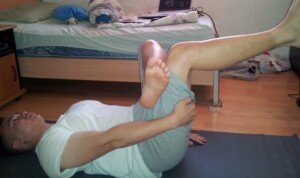Does pain in your leg from the hip to the ankle occur while you’re driving?
Have you tried adjusting the seat or squirming around in an attempt to get rid of the achy feeling?
You should not be experiencing discomfort in your leg while driving.
“The way that you set yourself up from a postural standpoint when driving can cause these symptoms,” says Ashley Irvin, a licensed physical therapy assistant with 15+ years experience and co-founder of Intuitive Choice Physical Therapy & Wellness.
“If this is a habitual posture, then stiffness can lead to pain and symptoms down the leg over time.”
Pain in the Driving Leg Only
“If it occurs on the driving leg, this can be due to increased nerve tension in the sciatic nerve caused by the leg being in the stretched-out position while pressing the gas pedal,” says Irvin.
When the leg is stretched out, this causes the back of the leg to press more into the seat.
This pressure can then be irritating the sciatic nerve.
“To make sure this doesn’t happen in your driving leg, adjust your seat position to make sure you are close enough to the steering wheel and have your heel resting on the ground.
“You shouldn’t feel achy or a slight pull on the back of your leg; the longer you drive, the more tension occurs in your leg.”
Pain in the Non-Driving Leg
“If it occurs on the leg that is not pressing the pedal, this can be due to the hip being positioned in an externally or internally rotated position, which can cause more strain to your posterior hip and a muscle called your piriformis.
“This muscle has the sciatic nerve running through it, so if this muscle gets irritated, crampy or inflamed, it will cause symptoms in your leg.”
This situation even has a name: piriformis syndrome. If this muscle is tight, it’s more likely to irritate the sciatic nerve, and that includes while you’re driving.
“I would make sure when you’re driving that both legs are resting comfortably, avoid crossing your legs or having your non-driving leg unsupported in a way that can cause issues in the hip.
“If the position of your chair or leg doesn’t feel good in the first five minutes, it won’t feel good 30 minutes from then.”
Exercises for Piriformis Syndrome
The piriformis muscle may also be a culprit if the discomfort occurs only in the driving leg.
A more flexible piriformis will help reduce the discomfort or achy feeling, but you have to be consistent with the exercises, shown below.

Piriformis stretch. Freepik.com/yanalya

Piriformis stretch. Kpa1563, CreativeCommons
Guidelines for Stretching the Piriformis Muscle
Make an effort to stretch it on a daily basis, or at least three times a week.
Hold each stretch position for 30-60 seconds. Do not yank or aggressively pull at the leg.
You need not bend like a pretzel to stretch this muscle. Do two or three sets per session.
 Ashley Irvin is a licensed PTA and co-owner of Intuitive Choice Physical Therapy and Wellness. She provides holistic in-home care and addresses all factors that could be impacting her clients’ pain experience. She provides physical therapy, health coaching and personal training.
Ashley Irvin is a licensed PTA and co-owner of Intuitive Choice Physical Therapy and Wellness. She provides holistic in-home care and addresses all factors that could be impacting her clients’ pain experience. She provides physical therapy, health coaching and personal training.
 Lorra Garrick is a former personal trainer certified through the American Council on Exercise. At Bally Total Fitness she trained women and men of all ages for fat loss, muscle building, fitness and improved health.
Lorra Garrick is a former personal trainer certified through the American Council on Exercise. At Bally Total Fitness she trained women and men of all ages for fat loss, muscle building, fitness and improved health.
.










































